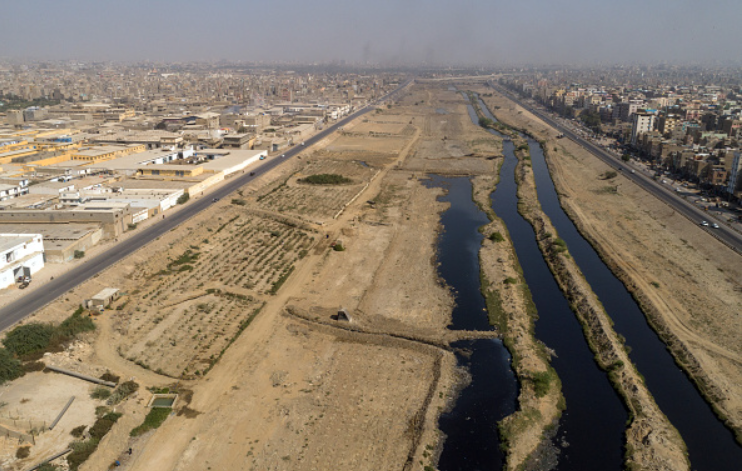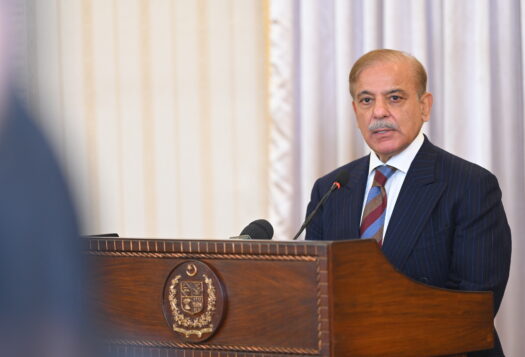
Despite a recent political emphasis on the impact of climate change in the country, Pakistan’s environmental crisis is worsening. A marked increase in carbon emissions due to extensive use of fossil fuels to produce energy and air pollution has further exacerbated the country’s environmental issues. Pakistan is ranked among the top ten most affected and most vulnerable to climate change as is illustrated by its irregular rainfall patterns, heat waves, droughts, and increased glacier-melting. Natural resource degradation, pollution, and climate change are the core environmental challenges of the country, and if not addressed and managed properly, could easily jeopardize sustainable economic growth—with environmental degradation costing an estimated six percent of GDP per year.
Officially announced in 2015, the China-Pakistan Economic Corridor (CPEC)—a massive bilateral infrastructure and connectivity project and subsidiary of China’s Belt and Road Initiative (BRI), aimed at modernizing Pakistan’s energy and transportation sectors—has historically not prioritized environmental sustainability. From exploiting non-renewable resources for energy projects to land-acquisition and displacing local communities, the Corridor lacks the enforcement of environmental and social safeguard policies and laws to ensure sustainable development of the region.
Natural resource degradation, pollution, and climate change are the core environmental challenges of the country, and if not addressed and managed properly, could easily jeopardize sustainable economic growth—with environmental degradation costing an estimated six percent of GDP per year.
Although CPEC projects have helped address power-shortages and outages across Pakistan, much of this was through coal power. China has emerged as a major investor in the coal power sector of international markets, financing up to USD $21-38 billion overseas—investments which potentially lack stringent environmental guidelines. So far, there are several legal national and international frameworks such as environmental and social impact assessments, resettlement policy frameworks and land use plans in CPEC projects. However, there are no environment and safeguard guidelines and climate change frameworks under the CPEC agreement explicitly to ensure the sustainability aspect of development. As one of the most vulnerable countries to climate change it is critical to address these issues through proper mitigation and environmental legislation and laws that create a framework for Pakistan’s longer-term sustainable development.
Coal, Carbon Emissions, and CPEC Projects
Pakistan’s extensive coal reserves in the Thar Desert have long been seen for their potential for power production. Thus, nearly half of the proposed CPEC energy-generation projects make use of coal, contradicting the environment friendly rhetoric surrounding the economic corridor. Recent sustainability assessments have highlighted that Thar coal cannot counter Pakistan’s long-term energy crisis. Although these projects were suggested to overcome the energy shortage and improve domestic energy security, a recent study estimates that the Levelized Cost of Energy (which factors in lifetime costs of the project and total energy production) of coal power plants to be much higher and does not include 32 percent of the total external costs associated with environmental and socio-economic costs such as water pollution, toxic coal waste, air pollution, long-term damage to the country’s ecosystem, and disastrous impact on health. Energy production from the Thar Coal Power Plant can additionally lead to an increase of 51 million tons in Pakistan’s greenhouse gas emissions. These coal power plants, thus, could lock the country in carbon intensive assets for decades and the country would miss the opportunity to harness the potential of renewable energy, namely solar and wind, as a pathway towards a carbon-free and climate-resilient energy system to achieve the Sustainable Development Goals.

In addition, CPEC envisages major upgrades and overhauls to Pakistan’s transportation infrastructure, with financing of about USD $10.63 billion for transportation projects. Most of the national freight in Pakistan is carried by old aged Heavy-duty trucks (HDTs) with almost no vehicular emission standards. The number of HDTs is expected to be double or more of current trucks in Pakistan because of China’s trade volume will cross by inland CPEC in next coming years which will further add up 36.5 million tons of CO2 which may contribute to severe air pollution and climate problems in country. Large scale infrastructure projects also requires land clearing by cutting down of trees and vegetation, destroying natural habitats of many species. This along with land acquisition and relocation of the communities are linked with major disputes over water, land, livelihoods and cultural values of the region.
Opportunities for a Greener Future
As the threats of climate change become a more pressing issue globally, Pakistan’s recent policies and initiatives have strongly advocated the need to transition towards clean energy resources. While the country is still reliant on coal for maintaining power generation, Pakistan’s Prime Minister Imran Khan declared a moratorium on new coal-based power projects—reportedly stepping back from two potential coal-projects in favor of hydroelectricity. In 2020, the country also approved the Alternative and Renewable Energy Policy 2019, which set up an ambitious plan have 30 percent of its national energy generated by alternative and renewable energy sources and another 30 percent through hydro projects by 2030. The current government has a promoted an agenda of a “Clean and Green Pakistan”, along with initiatives such as Ten Billion Tree Tsunami, Ecosystem Restoration funds, and innovative green financing tools.
On China’s side, facing criticism for support of non-renewable energy projects in the BRI, China has stated a refocus on cleaner energy and stepping away from coal in BRI projects in its most recent Five-Year Plan released in 2020. As a major BRI project, greening CPEC could be instrumental in showing a commitment to these broader policies. While there is much to be done, and there is skepticism regarding the BRI’s ongoing coal-power projects, there are some promising signs of moving towards more renewable sources of energy, including both China and Pakistan’s verbal commitments to halting new coal-power projects and energy sector reports that the share of fossil fuel financing (coal, gas, and oil) has been decreasing in CPEC, while the amount invested in renewable energies, particularly hydropower has been increasing with a total capacity of over 3,600 Megawatts. China is also the world’s largest producer of wind and solar energy, and has the capacity to support renewable energy developments and projects.
Facing criticism for support of non-renewable energy projects in the BRI, China has stated a refocus on cleaner energy and stepping away from coal in BRI projects in its most recent Five-Year Plan released in 2020. As a major BRI project, greening CPEC could be instrumental in showing a commitment to these broader policies.
Conclusion
Considering the developments under CPEC, it is clear that both countries aspire to engage in clean energy cooperation to ensure energy security and sustainability in Pakistan—however, there are remaining practical challenges to implementing this vision. To match aspirations for cleaner energy projects, China and Pakistan will need to formulate guidelines for a green investment project roadmap to address the environmental and social risks of CPEC investments.
China’s policymakers and financial institutions and banks can play a vital role in taking a more diverse leadership role in line with the concept and vision of global energy governance, commitment to the Paris Agreement, and national commitments to greener policies. Pakistan’s policymakers must make a simultaneous push for pulling coal out along with the removal of policy barriers for renewable energy acceleration under the auspices of Pakistan’s Alternative and Renewable Energy policy. To support these aims, Pakistan will also need to establish a detailed policy framework, entailing environmental and socio-economic safeguards, laws and pollution liabilities in CPEC projects. One potential aspect for this could be introducing green freight transport policies to deepen sustainability along the transport corridor and integrating natural capital accounting in the policy design. Moreover, given that Pakistan is in process of establishing the Special Economic Zones (SEZs) under CPEC, the low-carbon SEZs model and adopting green/eco-policies can be adopted in the planning and development, including green financing tools, climate mitigation policies, sustainable infrastructures and investments.
***


